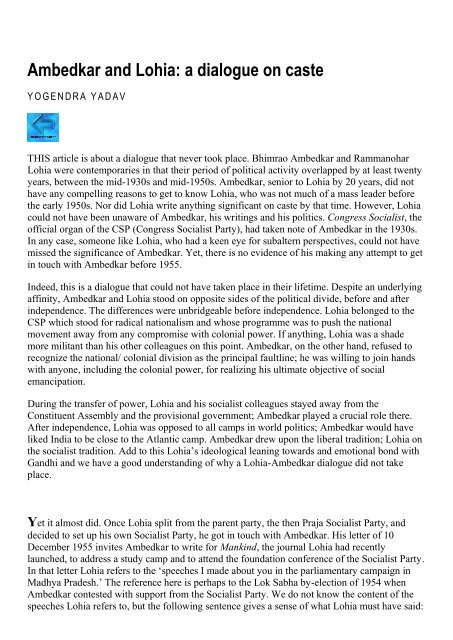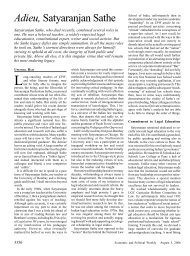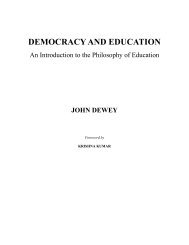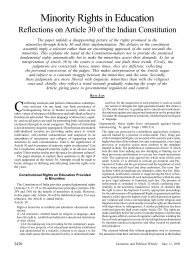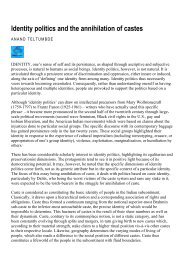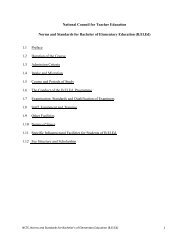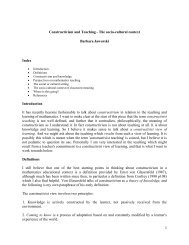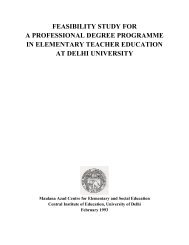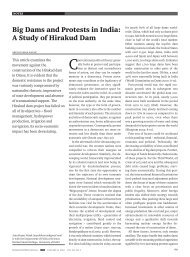Ambedkar and Lohia: a dialogue on caste - Eledu.net
Ambedkar and Lohia: a dialogue on caste - Eledu.net
Ambedkar and Lohia: a dialogue on caste - Eledu.net
- No tags were found...
Create successful ePaper yourself
Turn your PDF publications into a flip-book with our unique Google optimized e-Paper software.
An underst<str<strong>on</strong>g>and</str<strong>on</strong>g>ing of the foundati<strong>on</strong>al c<strong>on</strong>victi<strong>on</strong>s that <str<strong>on</strong>g>Ambedkar</str<strong>on</strong>g> <str<strong>on</strong>g>and</str<strong>on</strong>g> <str<strong>on</strong>g>Lohia</str<strong>on</strong>g> shared <str<strong>on</strong>g>and</str<strong>on</strong>g> how<str<strong>on</strong>g>Lohia</str<strong>on</strong>g> extended some of <str<strong>on</strong>g>Ambedkar</str<strong>on</strong>g>’s suggesti<strong>on</strong>s is not enough to set up a creative <str<strong>on</strong>g>dialogue</str<strong>on</strong>g>between the two. <str<strong>on</strong>g>Ambedkar</str<strong>on</strong>g> <str<strong>on</strong>g>and</str<strong>on</strong>g> <str<strong>on</strong>g>Lohia</str<strong>on</strong>g> diverged in two fundamental respects. These differenceshave substantial implicati<strong>on</strong>s for the politics of social justice in c<strong>on</strong>temporary India. Therefore,an attempt to learn from both of them requires that we c<strong>on</strong>fr<strong>on</strong>t these radical differences.The first difference pertains to their political strategy. <str<strong>on</strong>g>Ambedkar</str<strong>on</strong>g> followed a strategy of politicalsegregati<strong>on</strong> of dalits from the rest of Hindu society. Forging a distinct identity, recogniti<strong>on</strong> ofdifferential interests <str<strong>on</strong>g>and</str<strong>on</strong>g> securing separate political representati<strong>on</strong> were central to <str<strong>on</strong>g>Ambedkar</str<strong>on</strong>g>’spolitical strategy for the destructi<strong>on</strong> of the <strong>caste</strong> system. Specific acti<strong>on</strong>s like support for aseparate electorate, system of reservati<strong>on</strong>s or c<strong>on</strong>versi<strong>on</strong> to Buddhism followed from thisunderst<str<strong>on</strong>g>and</str<strong>on</strong>g>ing. To be sure, there was an aggregative element to this segregative strategy. Itmeant bringing together thous<str<strong>on</strong>g>and</str<strong>on</strong>g>s of <strong>caste</strong>s <str<strong>on</strong>g>and</str<strong>on</strong>g> sub-<strong>caste</strong>s which were then called‘untouchables’. The formati<strong>on</strong> of the Labour Party <str<strong>on</strong>g>and</str<strong>on</strong>g> then the Republican Party of India alsoindicated a desire for joining other victims of injustice. But <str<strong>on</strong>g>Ambedkar</str<strong>on</strong>g>’s principal strategyremained a politics of, for, <str<strong>on</strong>g>and</str<strong>on</strong>g> by the ‘untouchables’.This strategy has, of course, the merit of generating a sense of solidarity <str<strong>on</strong>g>and</str<strong>on</strong>g> political energy<str<strong>on</strong>g>and</str<strong>on</strong>g> has therefore been the unspoken ideology of dalit <str<strong>on</strong>g>and</str<strong>on</strong>g> backward <strong>caste</strong> politics in postindependenceIndia. As a result, the segregative impulse of the politics of social justice hasgained at the cost of an aggregative impulse. In many ways this was an extensi<strong>on</strong> of the divisi<strong>on</strong>of political labour in col<strong>on</strong>ial times: nati<strong>on</strong>alist politics stood for aggregati<strong>on</strong> while social justicemovements were charged with segregati<strong>on</strong>.But with the politics of social justice gaining ground, the lines have got blurred. Dalit politicstoday is as much about a search for aggregati<strong>on</strong> as it is about setting dalits apart from the rest ofthe <strong>caste</strong> Hindus. Mayawati’s dilemma illustrates this well: in order to stay in power, she needsto retain her ‘dalit’ base by maintaining the political aggregati<strong>on</strong> of Jatavs with n<strong>on</strong>-Jatav dalits.At the same time she knows <strong>on</strong>ly too well that all the dalit votes are insufficient for her to retainpower. Hence the shift from bahujan samaj to sarvajan samaj. Dalit leadership today is also atthe receiving end of the politics of segregati<strong>on</strong>, as in the Mala-Madiga dispute in AndhraPradesh <str<strong>on</strong>g>and</str<strong>on</strong>g> Jatav-Balmiki differences in much of North India. Faced with these dem<str<strong>on</strong>g>and</str<strong>on</strong>g>s, thedalit leadership often ends up behaving just as the nati<strong>on</strong>alist leadership did vis-a-vis the forcesof social justice.This c<strong>on</strong>text requires us to think about aggregative politics of social justice. At an abstractplane, <str<strong>on</strong>g>Lohia</str<strong>on</strong>g> appears to offer a way out. His politics of social justice was aggregative in itsimpulse. This aggregati<strong>on</strong> was multi-dimensi<strong>on</strong>al: he was for fusing various <strong>caste</strong>-groups underan umbrella category like shudra; he wanted to bring together various <strong>caste</strong> groups such as theshudra with dalits <str<strong>on</strong>g>and</str<strong>on</strong>g> adivasis; <str<strong>on</strong>g>and</str<strong>on</strong>g> he proposed an alliance of victims of the <strong>caste</strong> system withMuslims, women <str<strong>on</strong>g>and</str<strong>on</strong>g> the poor. To be sure, there was necessarily a segregative element in thisaggregative politics. <str<strong>on</strong>g>Lohia</str<strong>on</strong>g>’s sharp attack <strong>on</strong> upper <strong>caste</strong> Hindu dominati<strong>on</strong> of public <str<strong>on</strong>g>and</str<strong>on</strong>g>political life made him appear no different from advocates of segregative politics. But an overall
underst<str<strong>on</strong>g>and</str<strong>on</strong>g>ing of <str<strong>on</strong>g>Lohia</str<strong>on</strong>g>’s politics makes it clear that he was engaged in aggregating a historicbloc of the victims of multi-dimensi<strong>on</strong>al oppressi<strong>on</strong> <str<strong>on</strong>g>and</str<strong>on</strong>g> injustice in Indian society.The difficulty is that this aggregative politics remained an abstract principle. <str<strong>on</strong>g>Lohia</str<strong>on</strong>g>’s ownpolitics <str<strong>on</strong>g>and</str<strong>on</strong>g> that of his followers did not manage to achieve even a semblance of thisaggregati<strong>on</strong>. In effect, this traditi<strong>on</strong> of politics of social justice remained a segregative politics ofthe backward <strong>caste</strong>s or attempts at aggregati<strong>on</strong> under the leadership of the better off backward<strong>caste</strong>s. This politics was driven by compulsi<strong>on</strong>s not different from those of dalit politics:aggregative politics often fails to generate felt solidarity <str<strong>on</strong>g>and</str<strong>on</strong>g> does not translate into politicalenergy. C<strong>on</strong>fr<strong>on</strong>ting this radical difference between <str<strong>on</strong>g>Ambedkar</str<strong>on</strong>g> <str<strong>on</strong>g>and</str<strong>on</strong>g> <str<strong>on</strong>g>Lohia</str<strong>on</strong>g> thus invites us to facea historic challenge of c<strong>on</strong>structing a politics of aggregati<strong>on</strong> at the c<strong>on</strong>crete level without losinga minimal coherence <str<strong>on</strong>g>and</str<strong>on</strong>g> loyalty of the groups whose cause it espouses. Both of them help us toframe this questi<strong>on</strong> but do not necessarily offer us answers.The sec<strong>on</strong>d radical difference pertains to their cultural politics. As noted above, both <str<strong>on</strong>g>Ambedkar</str<strong>on</strong>g><str<strong>on</strong>g>and</str<strong>on</strong>g> <str<strong>on</strong>g>Lohia</str<strong>on</strong>g> recognized the spiritual need of the oppressed <str<strong>on</strong>g>and</str<strong>on</strong>g> underscored the necessity ofcombating <strong>caste</strong> ideology at the level of principles. But they proposed radically different waysof doing so. <str<strong>on</strong>g>Ambedkar</str<strong>on</strong>g> believed in destroying the fountainhead of the ideology of the <strong>caste</strong>system. He was c<strong>on</strong>vinced that the <strong>caste</strong> system drew its foundati<strong>on</strong>al principles from <str<strong>on</strong>g>and</str<strong>on</strong>g> wassanctified by the Hindu scriptures. Therefore, the high textual traditi<strong>on</strong> of Hindu shastras wasthe principal site of his critique. His method was that of a hermeneutics of suspici<strong>on</strong>. For himthe traditi<strong>on</strong> was nothing but hierarchy <str<strong>on</strong>g>and</str<strong>on</strong>g> oppressi<strong>on</strong> <str<strong>on</strong>g>and</str<strong>on</strong>g> any voice of protest within thistraditi<strong>on</strong> was necessarily compromised. Hence the need for a critique from outside. <str<strong>on</strong>g>Ambedkar</str<strong>on</strong>g>drew up<strong>on</strong> traditi<strong>on</strong>s of western rati<strong>on</strong>alism to attack the Hindu ideology of hierarchy. Much ofthe dalit movement after <str<strong>on</strong>g>Ambedkar</str<strong>on</strong>g> has followed him in this strategy. The trouble with thisstrategy is that more often than not it fails to establish a meaningful c<strong>on</strong>nect with the world viewof those whose cause it espouses; by depriving its subjects of identity, memory <str<strong>on</strong>g>and</str<strong>on</strong>g> history, thispolitics often disempowers itself.<str<strong>on</strong>g>Lohia</str<strong>on</strong>g> offers a radically different path of internal critique. He was simply not interested in thehigh textual traditi<strong>on</strong> of the Vedas ordharmashastras. His favourite site was Hindu mythology<str<strong>on</strong>g>and</str<strong>on</strong>g> epics like Ramayana <str<strong>on</strong>g>and</str<strong>on</strong>g> Mahabharata. His critique did not operate from outside; he pickedup his counter-symbols <str<strong>on</strong>g>and</str<strong>on</strong>g> counter-narratives from within these mythologies.Ram’s maryada was juxtaposed to Krishna’s amaryadit pers<strong>on</strong>ality, Draupadi was invoked as amodel of womanhood to counter Savitri, <str<strong>on</strong>g>and</str<strong>on</strong>g> alternative to the Brahminic Vashishtha traditi<strong>on</strong>of Hinduism was the Valmiki traditi<strong>on</strong>. Instead of debunking mythologies, <str<strong>on</strong>g>Lohia</str<strong>on</strong>g> preferred aretelling of these stories. <str<strong>on</strong>g>Lohia</str<strong>on</strong>g> engaged with deities <str<strong>on</strong>g>and</str<strong>on</strong>g> other mythological characters withunabashed admirati<strong>on</strong> <str<strong>on</strong>g>and</str<strong>on</strong>g> yet from an avowedly atheist positi<strong>on</strong> that reserved the right to beirreverent <str<strong>on</strong>g>and</str<strong>on</strong>g> critical.<str<strong>on</strong>g>Lohia</str<strong>on</strong>g> enunciated this new <str<strong>on</strong>g>and</str<strong>on</strong>g> innovative form of cultural politics through his lectures <str<strong>on</strong>g>and</str<strong>on</strong>g>public positi<strong>on</strong>s, but could not translate this into politics <strong>on</strong> the ground. Unlike <str<strong>on</strong>g>Ambedkar</str<strong>on</strong>g>’scritique, <str<strong>on</strong>g>Lohia</str<strong>on</strong>g>’s br<str<strong>on</strong>g>and</str<strong>on</strong>g> of cultural criticism did not leave behind a political legacy outside asmall circle of intellectuals. This absence was not accidental <str<strong>on</strong>g>and</str<strong>on</strong>g> points to the difficulties inturning <str<strong>on</strong>g>Lohia</str<strong>on</strong>g>’s critique into vibrant politics. Unlike <str<strong>on</strong>g>Ambedkar</str<strong>on</strong>g>, <str<strong>on</strong>g>Lohia</str<strong>on</strong>g>’s cultural politics
emained in the form of hints <str<strong>on</strong>g>and</str<strong>on</strong>g> was never spelt out. No w<strong>on</strong>der, his followers picked up thesymbols <str<strong>on</strong>g>and</str<strong>on</strong>g> phrases but not the point. <str<strong>on</strong>g>Lohia</str<strong>on</strong>g> himself deftly combined admirati<strong>on</strong> formythological figures with their thoroughgoing critique, but did not specify the grounds of such acritique. This left open the possibility of a less critical engagement with traditi<strong>on</strong>s that<str<strong>on</strong>g>Ambedkar</str<strong>on</strong>g> alerted us to. In this respect too, an appreciati<strong>on</strong> of the radical differences between<str<strong>on</strong>g>Ambedkar</str<strong>on</strong>g> <str<strong>on</strong>g>and</str<strong>on</strong>g> <str<strong>on</strong>g>Lohia</str<strong>on</strong>g> reminds us of the need for a new cultural politics of social justice, apolitics that combines underst<str<strong>on</strong>g>and</str<strong>on</strong>g>ing with critique that marshals powerful cultural resources tomount an effective attack <strong>on</strong> a system of injustice <str<strong>on</strong>g>and</str<strong>on</strong>g> oppressi<strong>on</strong>.The <str<strong>on</strong>g>dialogue</str<strong>on</strong>g> between <str<strong>on</strong>g>Ambedkar</str<strong>on</strong>g> <str<strong>on</strong>g>and</str<strong>on</strong>g> <str<strong>on</strong>g>Lohia</str<strong>on</strong>g> did not take place, much to the eternal regret ofadvocates of social justice who would have liked them to come together. However, it is not clearthat such a <str<strong>on</strong>g>dialogue</str<strong>on</strong>g> would have been successful had it taken place in their own lifetime.<str<strong>on</strong>g>Ambedkar</str<strong>on</strong>g> <str<strong>on</strong>g>and</str<strong>on</strong>g> <str<strong>on</strong>g>Lohia</str<strong>on</strong>g> were both str<strong>on</strong>g-headed leaders, with a grudge against history. Theythought in <str<strong>on</strong>g>and</str<strong>on</strong>g> spoke very different political vocabularies. Besides, <str<strong>on</strong>g>Lohia</str<strong>on</strong>g>’s social locati<strong>on</strong> – hewas after all a <strong>caste</strong> Hindu Bania – did not help. Therefore, it is hard to be sanguine about theoutcome of a <str<strong>on</strong>g>dialogue</str<strong>on</strong>g>.The attitude of their followers c<strong>on</strong>firms this suspici<strong>on</strong>. The <str<strong>on</strong>g>Ambedkar</str<strong>on</strong>g>ites are still unwilling totrust <str<strong>on</strong>g>Lohia</str<strong>on</strong>g>, or any socialist for that matter, as ideological ancestors. Mulayam Singh Yadav’sinvocati<strong>on</strong> of <str<strong>on</strong>g>Lohia</str<strong>on</strong>g> may have c<strong>on</strong>firmed his image as an OBC champi<strong>on</strong>. <str<strong>on</strong>g>Lohia</str<strong>on</strong>g>’s attempt tothink of <strong>caste</strong> al<strong>on</strong>g with class <str<strong>on</strong>g>and</str<strong>on</strong>g> gender is likely to appear as a diluti<strong>on</strong> to the <str<strong>on</strong>g>Ambedkar</str<strong>on</strong>g>ites.To the <str<strong>on</strong>g>Lohia</str<strong>on</strong>g>ites, any<strong>on</strong>e other than their own ‘doctor sahib’ is unacceptable. They think that<str<strong>on</strong>g>Lohia</str<strong>on</strong>g> had transcended the <strong>on</strong>e-dimensi<strong>on</strong>al thinking represented by <str<strong>on</strong>g>Ambedkar</str<strong>on</strong>g>. Reading<str<strong>on</strong>g>Ambedkar</str<strong>on</strong>g> after <str<strong>on</strong>g>Lohia</str<strong>on</strong>g> would look to them like reading Feuerbach after having understoodMarx. In this sense, it was perhaps not all that tragic that <str<strong>on</strong>g>Ambedkar</str<strong>on</strong>g> <str<strong>on</strong>g>and</str<strong>on</strong>g> <str<strong>on</strong>g>Lohia</str<strong>on</strong>g> did not meet.Perhaps they wished to save their <str<strong>on</strong>g>dialogue</str<strong>on</strong>g> for another century.* This article is an abridged versi<strong>on</strong> of a l<strong>on</strong>ger research paper under preparati<strong>on</strong>. I have omitted here the l<strong>on</strong>g exegeses <strong>on</strong><str<strong>on</strong>g>Ambedkar</str<strong>on</strong>g> <str<strong>on</strong>g>and</str<strong>on</strong>g> <str<strong>on</strong>g>Lohia</str<strong>on</strong>g> <str<strong>on</strong>g>and</str<strong>on</strong>g> have removed notes <str<strong>on</strong>g>and</str<strong>on</strong>g> references, so as to present the main argument within the given word limit. Thefirst draft of the paper was presented at the Indian Institute of Advanced Study, Shimla <str<strong>on</strong>g>and</str<strong>on</strong>g> a revised versi<strong>on</strong> at the Faculty Retreatof the CSDS. I would like to thank all the participants for their generous comments <str<strong>on</strong>g>and</str<strong>on</strong>g> criticism. For a fuller versi<strong>on</strong> of thereading of the dilemmas of the politics of social justice in c<strong>on</strong>temporary India, see my ‘Rethinking Social Justice’, Seminar,September 2009. For a detailed expositi<strong>on</strong> of <str<strong>on</strong>g>Lohia</str<strong>on</strong>g>’s ideas, including his views <strong>on</strong> <strong>caste</strong>, see my ‘What is living <str<strong>on</strong>g>and</str<strong>on</strong>g> what is deadin Rammanohar <str<strong>on</strong>g>Lohia</str<strong>on</strong>g>?’ Ec<strong>on</strong>omic <str<strong>on</strong>g>and</str<strong>on</strong>g> Political Weekly, 2 October 2010.


